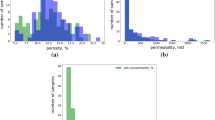Abstract
Knowledge of permeability, a measure of the ability of rocks to allow fluids to flow through them, is essential for building accurate models of oil and gas reservoirs. Permeability is best measured in the laboratory using special core analysis (SCAL), but this is expensive and time-consuming. This is the first major work on predicting permeability in the in the UK Continental Shelf (UKCS) based only on routine core analysis (RCA) data and a machine-learning approach. We present a comparative analysis of the various machine learning algorithms and validate the results, using permeability measured on 273 core samples from 104 wells. Results suggest that machine learning can predict permeability with relatively high accuracy. This opens new research directions in particular in the oil and gas sector.
This work is part of a Knowledge Transfer Partnership (KTP) programme, funded by Corex UK Ltd. and Innovate UK.
Access this chapter
Tax calculation will be finalised at checkout
Purchases are for personal use only
Similar content being viewed by others
References
Breiman, L., Friedman, J., Stone, C.J., Olshen, R.A.: Classification and Regression Trees. Taylor & Francis, Monterey (1984)
Brian Ripley: tree: Classification and Regression Trees (2019). https://CRAN.R-project.org/package=tree. r package version 1.0-40
Burges, C.J.: A tutorial on support vector machines for pattern recognition. Data Min. Knowl. Disc. 2(2), 121–167 (1998). https://doi.org/10.1023/A:1009715923555
Drucker, H., Burges, C.J.C., Kaufman, L., Smola, A.J., Vapnik, V.: Support vector regression machines. In: Mozer, M.C., Jordan, M.I., Petsche, T. (eds.) Advances in Neural Information Processing Systems, vol. 9, pp. 155–161. MIT Press (1997). http://papers.nips.cc/paper/1238-support-vector-regression-machines.pdf
Erofeev, A., Orlov, D., Ryzhov, A., Koroteev, D.: Prediction of porosity and permeability alteration based on machine learning algorithms. Transp. Porous Media 128(2), 677–700 (2019). https://doi.org/10.1007/s11242-019-01265-3
Francis, J.G.F.: Comput. J., 265–271 (1961). https://academic.oup.com/comjnl/article/4/3/265/380632
Friedman, J.H., Hastie, T., Tibshirani, R.: Regularization paths for generalized linear models via coordinate descent. J. Stat. Softw. 33(1), 1–22 (2010). https://www.jstatsoft.org/index.php/jss/article/view/v033i01
Fritsch, S., Guenther, F., Wright, M.N.: neuralnet: Training of neural networks (2019). https://CRAN.R-project.org/package=neuralnet
Gholami, R., Shahraki, A.R., Jamali Paghaleh, M.: Prediction of hydrocarbon reservoirs permeability using support vector machine (2012). https://www.hindawi.com/journals/mpe/2012/670723/
Gholami, R., Moradzadeh, A., Maleki, S., Amiri, S., Hanachi, J.: Applications of artificial intelligence methods in prediction of permeability in hydrocarbon reservoirs. J. Petrol. Sci. Eng. 122(C), 643–656 (2014). https://doi.org/10.1016/j.petrol.2014.09.007
Gümrah, F., Sarkar, S., Tasti, Y.A., Erbas, D.: Genetic algorithm for predicting permeability during production enhancement by acidizing. Energy Sources 23(3), 245–256 (2001). https://doi.org/10.1080/00908310151133942
Hegde, C., Gray, K.E.: Use of machine learning and data analytics to increase drilling efficiency for nearby wells. J. Nat. Gas Sci. Eng. 40, 327–335 (2017). https://doi.org/10.1016/j.jngse.2017.02.019
Hoerl, A.E., Kennard, R.W.: Ridge regression: biased estimation for nonorthogonal problems. Technometrics 42(1), 80–86 (2000). http://www.tandfonline.com/doi/abs/10.1080/00401706.2000.10485983
James, G., Witten, D., Hastie, T., Tibshirani, R.: An Introduction to Statistical Learning: with Applications in R. Springer Texts in Statistics. Springer-Verlag, New York (2013). https://doi.org/10.1007/978-1-4614-7138-7. https://www.springer.com/gp/book/9781461471370
Lee, J., Byun, J., Kim, B., Yoo, D.G.: Delineation of gas hydrate reservoirs in the Ulleung Basin using unsupervised multi-attribute clustering without well log data. J. Nat. Gas Sci. Eng. 46, 326–337 (2017). https://doi.org/10.1016/j.jngse.2017.08.007. http://www.sciencedirect.com/science/article/pii/S1875510017303104
McPhee, C., Reed, J., Zubizarreta, I.: Core Analysis: A Best Practice Guide. Developments in Petroleum Science, vol. 64. Elsevier, Amsterdam (2015)
Meyer, D., Dimitriadou, E., Hornik, K., Weingessel, A., Leisch, F.: e1071: Misc Functions of the Department of Statistics, Probability Theory Group (Formerly: E1071), TU Wien (2019). https://CRAN.R-project.org/package=e1071. r package version 1.7-3
Ottesen, B., Hjelmeland, O.: The Value Added from Proper Core Analysis, p. 12 (2008)
R Core Team: R: A language and environment for statistical computing (ISBN 3-900051-07-0). R Foundation for Statistical Computing (2019). https://www.R-project.org/
Riedmiller, M.: Advanced supervised learning in multi-layer perceptrons-from backpropagation to adaptive learning algorithms. Comput. Stan. Interfaces 16(3), 265–278 (1994). https://doi.org/10.1016/0920-5489(94)90017-5. https://linkinghub.elsevier.com/retrieve/pii/0920548994900175
Shang, C., Barnes, D.: Support vector machine-based classification of rock texture images aided by efficient feature selection. In: The 2012 International Joint Conference on Neural Networks (IJCNN), pp. 1–8, June 2012. https://doi.org/10.1109/IJCNN.2012.6252634
Singh, S.: Permeability Prediction Using Artificial Neural Network (ANN): A Case Study of Uinta Basin. Society of Petroleum Engineers (2005). https://doi.org/10.2118/99286-STU. https://www-onepetro-org.ezproxy.rgu.ac.uk/conference-paper/SPE-99286-STU
Stiles, J.J., Hutfilz, J.: The use of routine and special core analysis in characterizing Brent Group reservoirs, U.K. North Sea. J. Petrol. Technol. (U.S.) 44(6) (1992). https://doi.org/10.2118/18386-PA
Tibshirani, R.: Regression shrinkage and selection via the Lasso. J. Roy. Stat. Soc. B 58, 267–288 (1994)
Wold, H.: 11 - Path Models with Latent Variables: The NIPALS Approach**NIPALS = Nonlinear Iterative PArtial Least Squares. In: Blalock, H.M., Aganbegian, A., Borodkin, F.M., Boudon, R., Capecchi, V. (eds.) Quantitative Sociology: International Perspectives on Mathematical and Statistical Modeling, pp. 307–357. Academic Press, January 1975. https://doi.org/10.1016/B978-0-12-103950-9.50017-4. http://www.sciencedirect.com/science/article/pii/B9780121039509500174
Wold, S.: Personal memories of the early PLS development. Chemometrics and Intelligent Laboratory Systems 58(2), 83–84 (2001). https://doi.org/10.1016/S0169-7439(01)00152-6. http://www.sciencedirect.com/science/article/pii/S0169743901001526
Wong, K.W., Fung, C.C., Ong, Y.S., Gedeon, T.D.: Reservoir characterization using support vector machines. In: International Conference on Computational Intelligence for Modelling, Control and Automation and International Conference on Intelligent Agents, Web Technologies and Internet Commerce (CIMCA-IAWTIC 2006), vol. 2, pp. 354–359, November 2005. https://doi.org/10.1109/CIMCA.2005.1631494
Author information
Authors and Affiliations
Corresponding author
Editor information
Editors and Affiliations
Rights and permissions
Copyright information
© 2020 The Editor(s) (if applicable) and The Author(s), under exclusive license to Springer Nature Switzerland AG
About this paper
Cite this paper
Kontopoulos, H., Ahriz, H., Elyan, E., Arnold, R. (2020). Predicting Permeability Based on Core Analysis. In: Iliadis, L., Angelov, P., Jayne, C., Pimenidis, E. (eds) Proceedings of the 21st EANN (Engineering Applications of Neural Networks) 2020 Conference. EANN 2020. Proceedings of the International Neural Networks Society, vol 2. Springer, Cham. https://doi.org/10.1007/978-3-030-48791-1_10
Download citation
DOI: https://doi.org/10.1007/978-3-030-48791-1_10
Published:
Publisher Name: Springer, Cham
Print ISBN: 978-3-030-48790-4
Online ISBN: 978-3-030-48791-1
eBook Packages: Computer ScienceComputer Science (R0)




